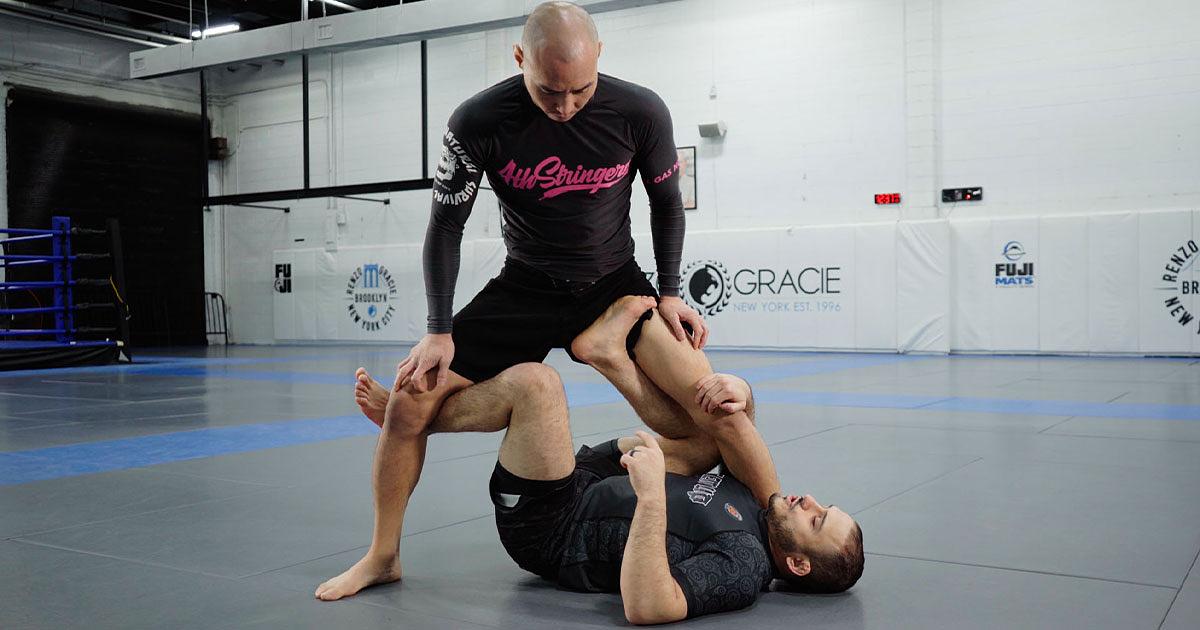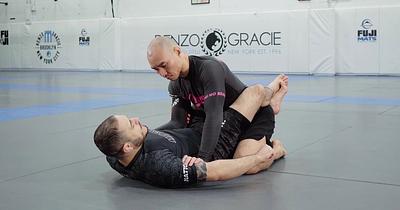What is the X Guard in BJJ?
by Team Digitsu
Updated: March 24, 2025

In the dynamic world of Brazilian Jiu-Jitsu (BJJ), the X Guard stands out as a powerful and versatile position that can significantly enhance your ground game. It is a form of open guard that puts you beneath your opponent, offering various sweeping and submission opportunities. The X Guard is particularly efficient when you find yourself on your back, as it allows you to control the space and unbalance your opponent even from what may initially seem like a disadvantageous position.
Pioneered by renowned BJJ practitioner Marcelo Garcia, the X Guard has become a staple in the arsenal of many grapplers. Its effectiveness lies in its ability to control an opponent's legs and hips with your own legs, creating leverage that can lead to sweeps or setting up submissions. As a position favored by competitors for its aggressive potential, learning the X Guard can be a game-changer in both gi and no-gi grappling.
While the X Guard might seem intricate at first, with practice, you can master its nuances, including how to enter the position, maintain control, and execute high-percentage sweeps to reverse roles with your adversary. Developing proficiency in the X Guard will add a new layer of complexity to your BJJ game, making it more difficult for opponents to predict and counter your moves.
Understanding the X Guard
Mastering the X Guard can significantly elevate your ground game by offering improved control and sweep options against standing opponents.
Fundamental Concepts
In BJJ, the guard is a foundational configuration where you utilize your legs to manage distance, control an opponent, and protect yourself from attacks. The X Guard is a specialized type of guard that is effective in both gi and no-gi grappling. This position allows you to off-balance your opponent and set up various sweeps and submissions.
Control and Balance
The essence of the X Guard lies in its ability to disrupt your adversary's balance. You achieve this by positioning your legs in such a way that you can control their weight distribution. It's essential to focus on the placement of your feet and the contact points on your opponent’s body to maintain effective control.
Standard X-Guard vs Variations
In the standard X-Guard, your legs form an "X" shape beneath your opponent while lying on your back. This basic position is designed to unbalance an opponent by manipulating their weight over you. When applying the standard X-Guard, you maintain a strong grip on their leg or pants, giving you leverage for transitions or to execute an X-Guard trip.
- Key Point: Maintain grips (on the gi or limbs in no-gi) and focus on undermining your opponent's base.
Variations
Although the basic framework of the X Guard is simple, several variations cater to different scenarios in the sport. For instance, the Single Leg X-Guard is altered by not crossing your legs but still setting up a pathway to the full X Guard or a sweep. Variations can be adapted depending on the specific context of the match and the fighters’ styles.
- Key Point: Explore variations to find what best suits your game and the given competitive situation.
Entry Techniques into X Guard
To transition effectively into the X Guard, you must capitalize on the openings from various guard positions. Choose the entry that best fits the situation at hand, focusing on achieving the inside position to gain control.
From Open Guard
Initiating X Guard from the open guard involves manipulating distance and using hooks to create leverage. When you are in open guard, focus on achieving an inside position. From there, employ a hook with your foot behind your opponent’s knee, then swing your other leg underneath their far thigh, establishing the X Guard structure. For an effective transition:
- Control your opponent's sleeve and collar, keeping their posture broken.
- Place your foot on their hip to maintain distance and position.
- Slide your other foot behind their knee to establish your first hook.
Combining Butterfly and Half Guard
The butterfly and half guard combination is a dynamic approach to slip into X Guard, especially when dealing with a resistant opponent. Utilize the butterfly guard to elevate and create off-balancing opportunities or shift to half guard to obtain underhooks and then transition into X Guard. Your steps include:
- In butterfly guard, use both your feet as hooks under your opponent’s thighs.
- Elevate and off-balance your opponent, looking for space to insert your leg for the X Guard.
- If countered, transition to half guard, secure an underhook, and then use a sweep motion to move into X Guard.
X Guard Sweeps and Transitions
Mastering X Guard sweeps and transitions is essential for securing dominant positions during a match. You will find that precision in movement and leverage can effectively unbalance and control your opponent, leading to superior control on the ground.
Common Sweeps from X Guard
- Technical Stand-up Sweep: When you have established X Guard, you can perform a technical stand-up by pushing your legs forward to destabilize your opponent, clearing the way to execute the sweep.

Danny Stolfi builds up towards the technical stand up sweep from X-Guard. - Sit-up Sweep: Should your opponent resist the technical stand-up, you may opt for a sit-up sweep. It involves sitting up by using your hand as a post on the mat and using the other hand to control your opponent's leg or belt.
By utilizing hooks and precise angles, you can create the necessary leverage to disrupt your opponent's balance, making the X Guard a powerful tool for sweeping.
Transitioning to Dominant Positions
- Mount: After a successful sweep from X Guard, transition to a mount position by driving your knee across your opponent's chest, securing a high-level control.
- Side Control: If you prefer side control, use your grip on the opponent's ankle or pants to guide their leg as you roll to establish the position.
Your goal should be to seamlessly move from destabilizing the opponent in the X Guard to establishing dominant position with control and precision.
X Guard Submission Attacks
The X Guard positions you strategically under your opponent, offering unique leverage for submissions, particularly those targeting the lower body. While the X Guard is primarily known for its sweeping capabilities, there are submission attacks that can be highly effective when applied correctly.
Upper Body Submissions
While not as common as lower body submissions from the X Guard, you can still execute several upper body submissions if your opponent's balance and defense are compromised. One possibility is the armbar, which you can set up by breaking their posture and controlling an arm. Another effective technique is the kimura submission; to accomplish this, manipulate your opponent's wrist and create the angle needed to secure their arm behind their back.
Lower Body Submissions
The X Guard shines in setting up a variety of leg locks. Heel hooks are among the most notorious, where you control your opponent's leg and twist the heel inward, applying pressure on the knee. Knee bars are another formidable submission, which straighten and pressure the opponent's leg between yours. The ankle lock is also available; it focuses on the Achilles tendon by wrapping your arm around the opponent's foot while using your legs to control their leg. Moreover, toe holds, twisting the foot by gripping the toes and the heel, can be utilized for a quick tap out. These leg attacks can be especially surprising for opponents who don't anticipate submission threats from the X Guard.
Defensive Strategies from X Guard
X Guard is a formidable position that allows you to maintain control while offering several defensive strategies. Protecting against guard passes and leg entanglements are crucial to maintaining your position and preventing your opponent from gaining the upper hand.
Preventing Guard Passes
When you're in the X Guard position, your primary goal is to prevent guard passes. Your legs and grips are your first line of defense. Here's how to use them effectively:
- Keep your legs active and tense. This creates barriers that your opponent must navigate to pass your guard.
- Adjust your grips frequently to maintain control of your opponent's legs, focusing on preventing the traditional passes.
- Use your foot placement to disrupt balance, making it difficult for them to stabilize and attempt a pass.
Protection from Leg Entanglements
Leg entanglements can compromise your position and open you up to submissions. Here’s how to safeguard yourself:
- Monitor your opponent's leg positioning closely to anticipate potential entanglement attempts.
- Use your hooks effectively to keep their legs separated, reducing the chances of entanglements.
- Always be ready to transition to other protective positions like the De La Riva guard, which can offer an additional layer of defense against entanglements.
By utilizing these strategies, you can enhance your defensive game from the X Guard position, keeping your opponents at bay and under control.
Training and Drilling X Guard
To effectively develop your X Guard, incorporating both solo and partner drills is essential. Through regular practice, you can enhance your movement and create fluid transitions during a roll.
Solo Drills
Movement Drills: Start with the technical stand-up to build core strength and improve your ability to move from the ground to a standing position seamlessly. It's a fundamental movement in BJJ that translates directly to improving your X Guard, as it aids in creating the necessary space to insert your legs into the X Guard position.
- At Home Drills: Allocate a space at home to practice your X Guard entries and rolling breakdowns. You may use a heavy bag or a similarly shaped object to simulate an opponent. Focus on shifting your weight and positioning your legs as if you were maneuvering into the X Guard.
Partner Drills
- Roll: Practice with a partner rolling into the X Guard position. Take turns so that each of you gets a feel for both the offensive and defensive aspects of the position.
- Entry Drills: Working with a partner, drill various entries into the X Guard, such as from a standing position or from a failed sweep attempt. Precision in your entry will ensure you have the control needed for effective sweeps.
- Sweep Drills: Once in the X Guard position, work on executing sweeps with your partner. They should offer varying degrees of resistance to better simulate a live roll scenario.
Remember, the key to mastering the X Guard is consistent and focused practice.


